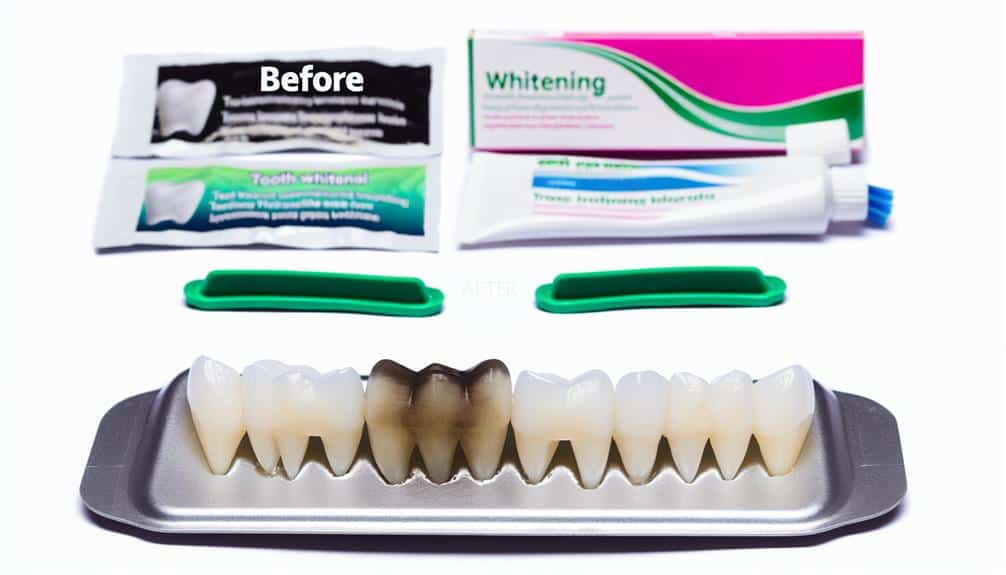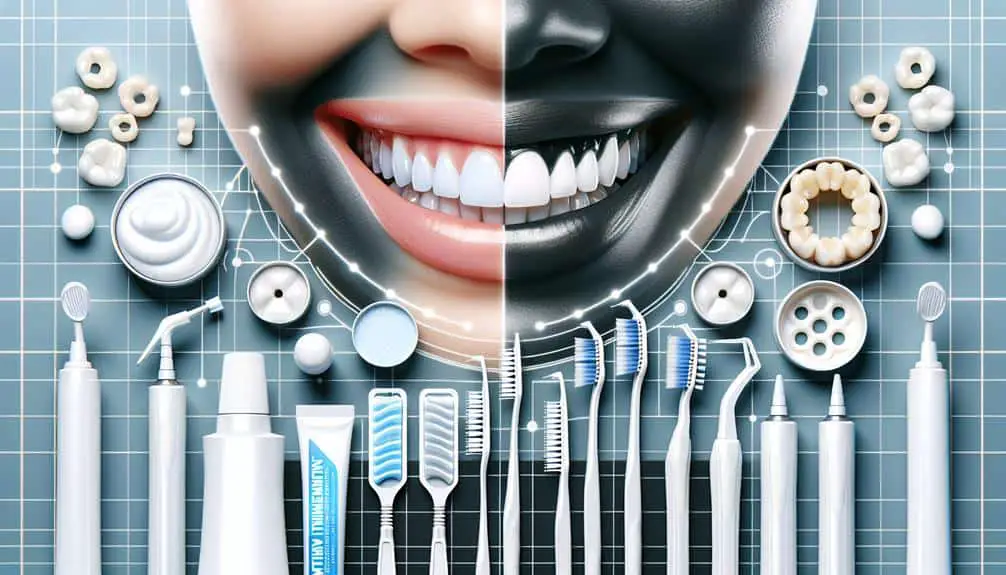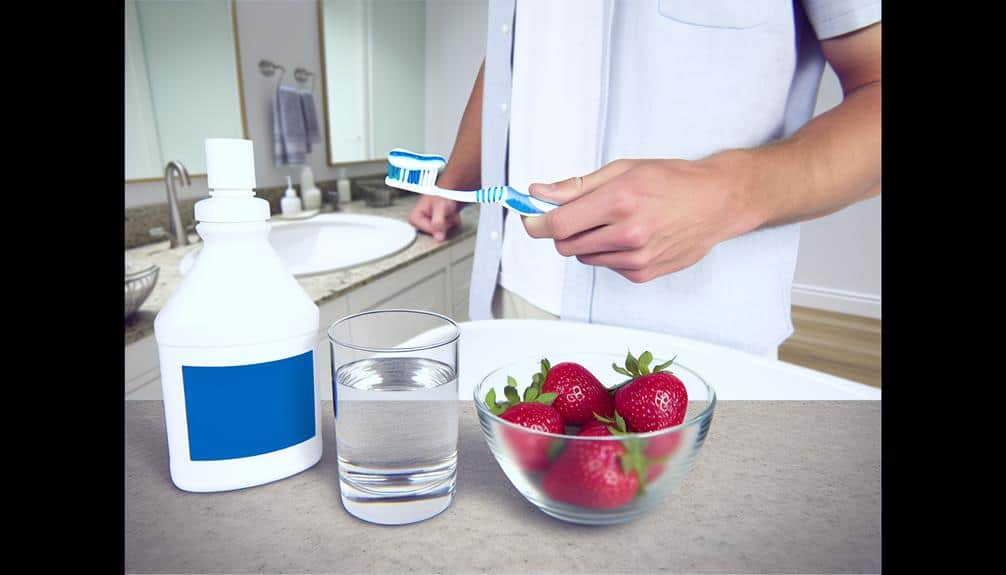Transform your smile with professional in-office whitening treatments like laser whitening and Zoom procedures that efficiently target stubborn tooth stains, delivering immediate results. For at-home options, consider using whitening kits with custom trays for even gel distribution or opt for whitening strips coated with peroxide-based gel for precise stain removal. Whitening toothpaste and mouthwashes are effective in reducing surface stains, while natural remedies like oil pulling and charcoal toothpaste can be gradually incorporated into your routine for whitening. Embrace these top treatments to enjoy a brighter smile, starting with proven methods that suit your needs.
Key Points
- Professional in-office whitening treatments like laser and Zoom provide immediate and effective results.
- At-home whitening kits with custom trays ensure even whitening gel distribution for favorable outcomes.
- Whitening strips coated with peroxide-based gel target stains effectively with teeth-conforming design.
- Whitening toothpaste and mouthwashes reduce surface stains with consistent use and patience for noticeable improvements.
- Natural remedies like oil pulling and charcoal toothpaste gradually whiten teeth when incorporated into oral care routine.
Professional In-Office Whitening Treatments
Professional in-office whitening treatments offer a quick and effective way to brighten your smile by targeting stubborn tooth stains. Among these treatments, laser whitening and Zoom treatment stand out as popular options due to their efficiency and immediate results. Laser whitening utilizes a special light that activates the whitening gel on your teeth, accelerating the whitening process. This method is known for its precision in targeting specific areas of discoloration, ensuring a more uniform and brighter smile.
On the other hand, Zoom treatment involves a bleaching process that's enhanced by a special light that helps the whitening gel penetrate the enamel and dentin, breaking down tough stains effectively. This procedure is often completed in just one visit to the dentist, making it a convenient choice for individuals seeking quick results. Both laser whitening and Zoom treatment are safe and supervised by professionals, ensuring that your teeth are whitened effectively without causing harm to your enamel or gums.
At-Home Whitening Kits With Custom Trays
Achieve a brighter smile at home with custom trays designed for whitening treatments that offer convenience and personalized results. Custom trays play a significant role in at-home whitening kits, ensuring even distribution of the whitening gel for best results.
Here are some essential points to keep in mind for maximizing the effectiveness of these kits:
- Tray customization tips: Properly molding the trays to fit your teeth snugly is essential for effective whitening.
- Consistent usage: Follow the recommended treatment schedule consistently for the most favorable outcomes.
- Choosing the right whitening gel: Opt for a reputable brand's whitening gel that suits your needs and sensitivity levels.
- Avoid DIY whitening techniques: While DIY methods may seem cost-effective, they can be harmful to your teeth and gums.
- Regular maintenance: After completing the treatment, maintain your results by practicing good oral hygiene habits and avoiding foods and drinks that stain teeth.
Whitening Strips for Targeted Stain Removal
For targeted removal of stains, consider utilizing whitening strips as a convenient and effective option for enhancing your smile. Whitening strips are thin, flexible plastic strips coated with a peroxide-based gel that can be applied directly to the teeth. These strips are designed to conform to the shape of your teeth, allowing the whitening gel to penetrate the enamel and target stubborn stains effectively.
Teeth whitening pens are another portable and easy-to-use option for targeted stain removal. These pens contain a whitening gel that can be directly applied to the teeth, offering a precise method for treating specific areas of discoloration.
Additionally, LED teeth whitening devices can complement the whitening strips or pens by accelerating the whitening process. LED lights emit a specific wavelength of blue light that activates the whitening gel, enhancing its effectiveness and promoting quicker results.
When used consistently and as directed, whitening strips, teeth whitening pens, and LED teeth whitening devices can help you achieve a brighter, more radiant smile by targeting and removing stubborn tooth stains.
Whitening Toothpaste and Mouthwashes
Utilizing whitening toothpaste and mouthwashes can help effectively reduce surface stains and enhance the brightness of your smile. When selecting these products, consider the following:
- Regular Use: Consistent use of whitening toothpaste and mouthwash is crucial to seeing results.
- Patience is Key: Results may not be immediate, but with consistent use, you should start to notice a difference.
- Avoid Staining Substances: To maximize the efficacy of these products, try to limit consumption of dark-colored foods and beverages that can stain teeth.
- Follow Instructions: Adhere to the usage instructions provided on the products for best results.
- Consult Your Dentist: If you have sensitive teeth or any concerns, consult your dentist before starting any whitening regimen.
When it comes to DIY whitening techniques, toothpaste and mouthwashes containing ingredients like hydrogen peroxide or carbamide peroxide have shown effectiveness in reducing stains. Make an informed decision based on your needs and preferences for a brighter smile.
Natural Remedies for Tooth Discoloration
To combat tooth discoloration naturally, consider incorporating simple yet effective remedies into your oral care routine. Oil pulling, a traditional Indian folk remedy, involves swishing a tablespoon of oil (such as coconut or sesame oil) around in your mouth for about 15-20 minutes. This process is believed to help remove bacteria and stains from the teeth, promoting a brighter smile.
Another natural remedy gaining popularity is charcoal toothpaste. Activated charcoal has adsorptive properties that can bind to particles, plaque, and surface stains on the teeth, helping to whiten them. It's essential to use charcoal toothpaste in moderation to prevent excessive abrasion on the enamel.
While these natural remedies can be beneficial, it's essential to remember that they may not deliver the same immediate results as professional treatments. Incorporating these practices into your oral care routine can be a gentle way to combat tooth discoloration over time, promoting a healthier and brighter smile.
Frequently Asked Questions
Are There Any Potential Side Effects or Risks Associated With Using Whitening Treatments for Stubborn Tooth Stains?
When using whitening treatments for stubborn tooth stains, potential side effects and risks may include tooth sensitivity and gum irritation. Long term effects and maintenance involve proper oral care and occasional touch-ups to sustain results.
Can Whitening Treatments Remove Stains Caused by Smoking or Certain Medications?
If you've been battling tooth stains from smoking or medications, natural remedies like baking soda can help. Consider long-term effects and success rates when exploring alternative options over harsh treatments for a healthier smile.
How Long Do the Results of Professional In-Office Whitening Treatments Typically Last?
After professional in-office whitening, results typically last around 6 months to 2 years. Effectiveness can vary based on habits like smoking, coffee consumption. To maintain results, brush regularly, use whitening toothpaste, avoid staining foods.
Are There Any Specific Dietary or Lifestyle Changes That Can Help Maintain the Results of Whitening Treatments?
To maintain whitening results, focus on natural remedies like crunchy fruits and veggies that help clean teeth. Improve oral hygiene with regular brushing and flossing. Avoid stain-causing habits like smoking and excessive coffee consumption.
Can Whitening Treatments Be Used on Sensitive Teeth Without Causing Discomfort?
Tooth sensitivity is common during whitening treatments. Manage pain with desensitizing toothpaste before and after sessions. Opt for professional supervision to tailor the treatment to your sensitivity level, ensuring minimal discomfort and effective results.



